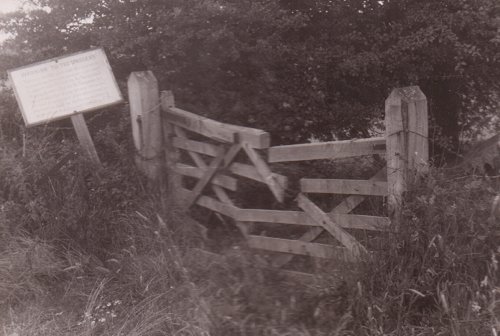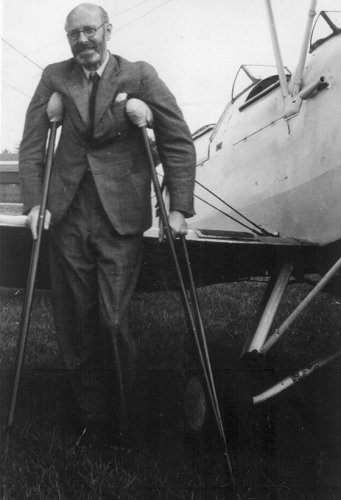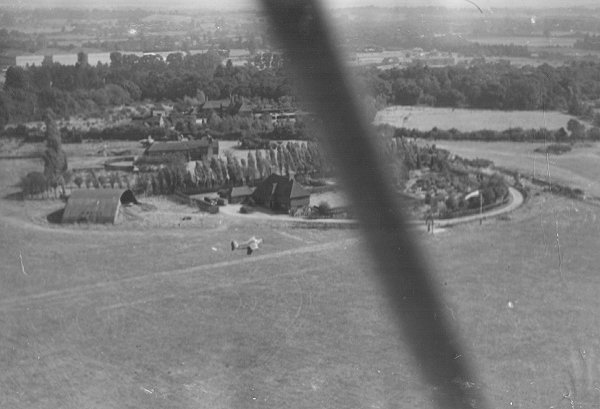|
1946 - Phoenix from the ashes
During the Second World War, all the surrounding flat fields and part of the golf course were incorporated into the airfield by the RAF. When they left, Denham was in a poor condition and deteriorated still further due to vandalism. Tilehouse Lane was reopened leaving the pre-war hangars on Mr Hewlett's land on the other side of the road. Hooligans took pleasure in smashing all the windows, anything removable and worth having was stolen. Aeroplanes that flew in were soon damaged by trespassers or cattle that the local farmer put on the aerodrome. Hundreds of tons of bomb rubble had been dumped and miles of wire and fencing had been stolen. Official and developer requests were made to turn the aerodrome into an estate for 2,000 houses or a gravel pit. A few local residents were not happy to have flying continue at the aerodrome and resorted to damaging fences and gates.
|

Despite the return of aircraft vandalism on the site, particularly from disgruntled neighbours, continued. Gates and fences were repeatedly cut or damaged, allowing cattle and sheep to stray onto the airfield.
|
As well as his medical work, Myles had to start a clean up campaign including replacing the gates and fences and cutting up miles of barbed and Dannet wire defences left behind by the military. Bottles and other rubbish of every kind had to be collected and removed. Myles, his groundsman and any volunteers who could be pressed into service, steadily cleared the airfield and its surroundings, pulling out ragwort, which is poisonous to cattle, as they went. Four blister hangars were left behind by the RAF but only one was on land that returned to the aerodrome. Even this one was missing its protective curtains which had been stolen. What was needed was the return of the steel framed hangars. Whilst inspecting the condition of these Myles fell off the roof and broke his pelvis, a very painful injury. A lesser person might have taken a back seat at this point but the fight to reclaim the airfield went on. Myles was seen supervising the on-going work from his crutches!
|

Myles Bickerton fought hard to keep the airfield open with both the pen and his own hands, carrying out many tasks himself. While surveying a hangar roof in 1946 he fell and broke his pelvis: this painful injury did not prevent him from carrying on business as usual.
|
As the situation stabilised the Air Training Corps gliding school was able to carry on flying. Airwork Ltd started a flying school but had to give up due to a lack of buildings. To improve the situation Myles tried to buy Halings House on the north side of the aerodrome to be used as a clubhouse, but the deeds showed that the house could only be used as a private dwelling so the sale was not completed, but Myles did go ahead with purchasing the land to the south of the house. Another house on the south side of the aerodrome, known as Bidston, was almost derelict and in a filthy state, having been requisitioned for military personnel and then abandoned. When they left, the house suffered further from squatters. Myles purchased this house in 1946 and repaired it at considerable expense due to the post war shortage of building materials which could only be obtained with permits. Commercial and training operations received a boost when Denham Air Services Ltd was formed with Messers R. Dimpfl, L. Gisborne and R. Short as directors. They immediately started operating as the Denham Aero Club, a club and flying school under Chief Flying Instructor Derek Wright, a former RAF instructor.
|

Bidston House was purchased in 1946 and quickly became the home of the newly formed Denham Aero Club. Note the blister hangar, a feature which would be quickly removed.
|
In November a second club moved into Denham when the Middlesex Flying Club took up residence in a disused nissen hut on the north side of the aerodrome. Aside from the physical work to restore the aerodrome, there was a battle of words and letters to be fought against all kinds of claims and local opposition. In response to this, Myles said if the site was not to be an aerodrome it could be turned into a gravel pit and filled up with London rubbish, but what the country needed most was a prison or a lunatic asylum! Myles was successful in countering these claims, and indeed was to begin to improve the facilities, as will be related next.
|
|

